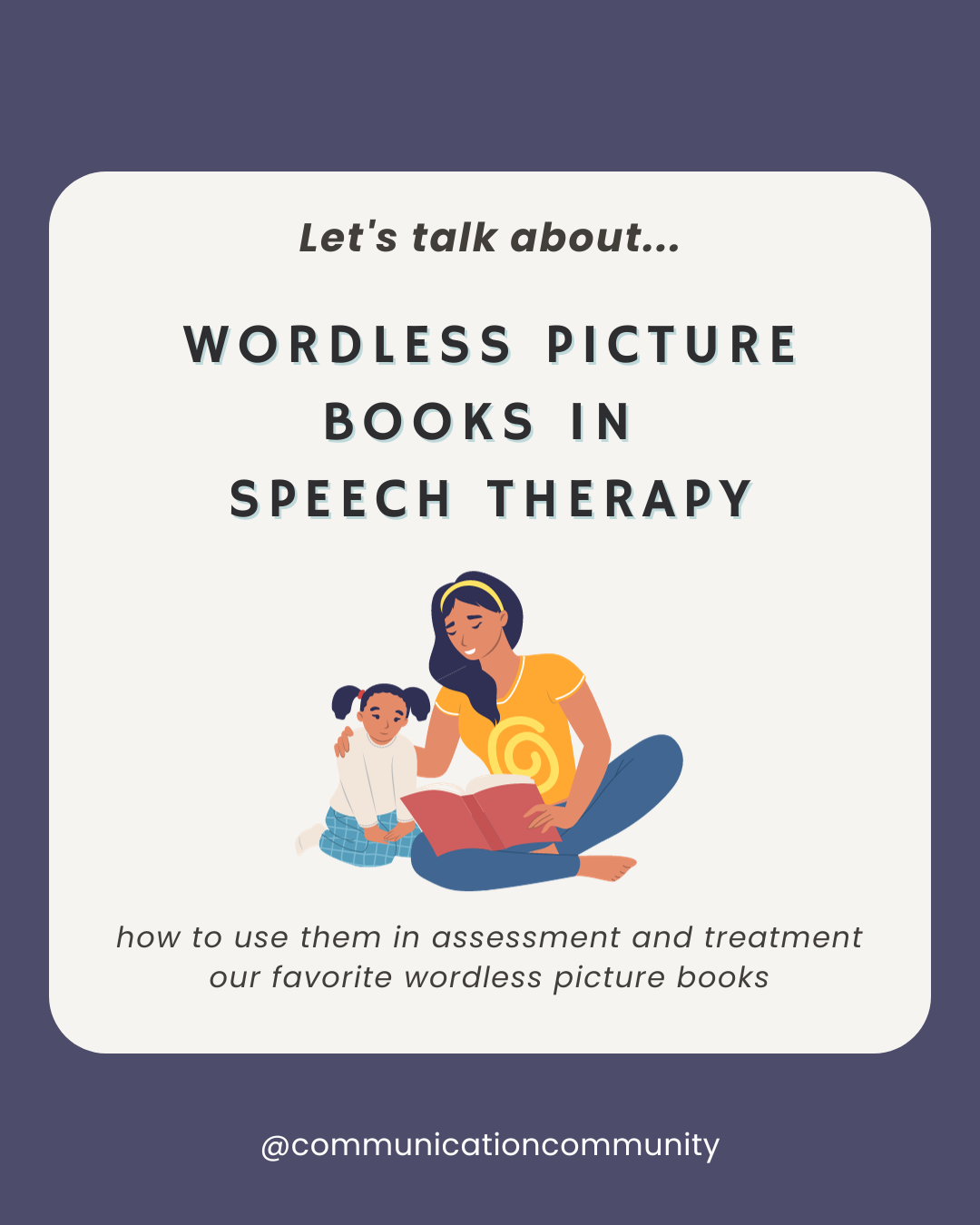Scroll down to see our top favorite wordless picture books for speech therapy!
What are Wordless Picture Books?
Wordless picture books are books that have pictures but no words. The pictures are detailed enough to tell a story without adding text. Because there is no text, “readers” have to rely on interpreting the pictures and story themselves.
Wordless Picture Books in Speech Therapy
Wordless picture books are used by SLPs for both the assessment and treatment of speech and language skills.
Wordless Picture Books in Speech Therapy Assessments
Wordless picture books are often used to evaluate speech and language skills in assessments. They are materials that can be used as informal assessments and are often used in conjunction with formal assessments. As a client looks at the book and tells the story in their own words, it can provide insights into their grammar, vocabulary, inference, and narrative skills, as well as assess how well their speech can be understood (i.e., their intelligibility).
As an SLP, you have the opportunity to observe a variety of speech and language skills while the client tells the story. Questions you can ask yourself may include:
- Is the client using mostly phrases or are they using complex sentences?
- What sequencing terms (if any) do they use to describe the order of events?
- Are they using specific vocabulary to describe the pictures, or do you hear a lot of “this,” “that,” and “it”s?
- Do they go off topic and on tangents while telling the story?
- Can they produce speech sounds accurately at the conversational level or are they hard to understand at times?
- What does their vocal volume sound like?
- Do they have a lot of stuttering moments?
You can also ask the client questions while they are telling the story. For example, you might ask how a character may be feeling (emotional understanding), why they may be feeling a certain way (emotional reasoning/inferencing), or what might happen next (predicting).
Wordless picture books can be used to assess a wide variety of skills and can be used across a broad age range, which makes them the perfect resource to keep in your therapy bag!
Wordless Picture Books in Speech Therapy Treatment
Though commonly used in assessments, wordless picture books are great activities for treatment sessions as well. As an SLP, you can use wordless picture books to help target a client’s specific goals. They are also great for mixed groups, where you are working with multiple clients with different goals, or for when there is not a lot of time to plan and you want to use the same activity with different clients throughout the day!
A favorite wordless picture book for speech therapy is Good Dog, Carl by Alexandra Day. It tells the story of a mother who leaves her baby at home and entrusts the pet dog (Carl) to look after the baby. While PROBLEM SOLVING might jump out as the first skill to address in this book, there are a lot of other great speech and language skills you can address as well 😝, such as…
Introducing Early Literacy and Emerging Communication Skills
Early literacy skills can be introduced using wordless picture books. These skills may include knowing what the cover of the book is, where the title is, how to turn pages, and understanding that the pictures (and words) tell a story. A client can listen to you tell the story and/or point out the pictures of the baby and Carl, and communicate that they want to keep looking at it by saying, “more,” “go,” or “turn page.”
Labeling Vocabulary and Understanding Basic Concepts
The story takes the baby and Carl all over the home and through many different activities. This gives the client opportunities to label different vocabulary in a home, such as “bed,” “bath,” “stairs,” and “laundry.” There are also many ways to address temporal words and prepositions: first, the baby is in the crib, then she is on top of Carl, they sit in front of the mirror, and later go down the laundry chute and stairs.
Expanding Sentence Structures
By describing the activities of the baby and Carl, clients can use different sentence structures. They may start simple with “[character] + is + [action]” sentences but can also expand into longer sentences, “[character] + is + [action] because…” When appropriate, using verbal or written sentence stems or sentence starters (e.g., “Carl is _____.”) can be helpful for clients, too.
Making Inferences about Emotions
As you go through the story, you can support your client in making inferences about how the characters are feeling. For example, when the baby is in the fish tank, you can ask your client, “How do you think she’s feeling swimming in the tank?” When Carl and the baby open the fridge, you can ask, “How do you think the baby might feel now?”
Anticipating Events
Making predictions and anticipating what will happen next is a great skill to address in wordless picture books as there is no text to tell you what *is* going to happen. You can ask questions such as, “What will happen next?” after Carl and the baby open the fridge, or “What do you think [character] is going to do before mom gets home?”
Navigating Problems
There is no shortage of “problems” in Good Dog, Carl, funny as they may be. A dog is not an adequate babysitter, a baby should neither go in the home fish tank nor down the laundry chute. Discussing problems, consequences, and possible solutions are possible activities for building problem-solving and self-awareness skills.
Reviewing Story Elements
Like any book, wordless picture books can also help support general narrative comprehension through the incorporation of story elements. Ask the client questions or model comments related to story elements. Common story elements include the setting, characters, main idea, plot, etc. Work on sequencing and organization by using a topic map or graphic organizer!
Retelling Events and Creating Summaries
After the whole story has been read, the client can retell what happened. Depending on what their goals are, you may focus on sequencing the events or using transition words. You can also use the reviewed story elements to help with the retelling or summarizing!
Wordless Picture Books: Expansion Activities
If you are looking for additional activities to expand on the wordless picture book you’ve chosen for your assessment/treatment activity, there are many ways to use it as a “jumping off” point.
Taking “Good Dog, Carl” as an example, you can:
- Think about another day of adventures if mom left Carl with the baby again
- Discuss categories: different pets besides dogs and fish, different snack options, different rooms in a home
- Put verbs into different tenses: if your client used sentences in the present tense when telling the story, e.g., “Carl gives baby a bath,” you can discuss what the verb would be like in different tenses, such as, “Carl gave the baby a bath” or, “Carl is going to give the baby a bath,” or “Carl will give the baby a bath.”
- Speech sound reinforcement: use different events from the story to reinforce speech sounds, e.g. /k/ in “Carl,” blends in “stairs,” and voiceless /th/ in “bath.”
Top Wordless Picture Books for Speech Therapy
- Good Dog, Carl by Alexandra Day
- A Boy, A Dog, and A Frog by Mercer Mayer (and many other spin-offs)
- Field Trip to Volcano Island by John Hare (also on the Epic! website)
- Flashlight by Lizi Boyd
- Penguin Sets Sail by Jessica Linn Evans
- Bearded Dragon, Home Alone by A.K. Beck
- Pancakes for Breakfast by Tomie DePaola
- The Red Book by Barbara Lehman
- The Snowman by Raymond Briggs
- The Lion and the Mouse by Jerry Pinkney



More Resources to Help You
- Find a compilation of our favorite books for speech and language development.
- Wordless videos are another great educational tool.
- Join our membership community! In our free Open Community, access our monthly freebies and newsletter. In our Premium Community, access our ever-growing resource library, discussion boards, and weekly office hours with one low monthly or annual price.
This post contains some affiliate links and we are (slightly) compensated if you use them, but all opinions are our own. We appreciate the support!


